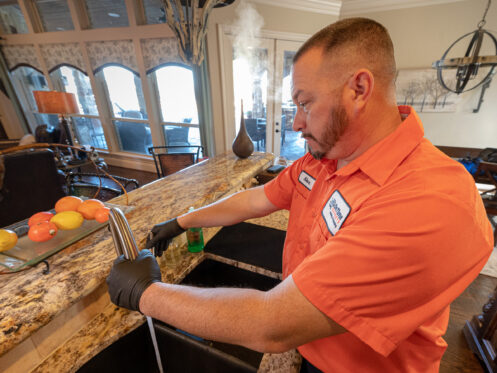People rely on their plumbing systems to send them fresh, clean water, but there are many ways that things can go wrong. If your plumbing system or water supplier fails to work correctly, you can end up with very poor water quality. Even when your water doesn’t look noticeably different, it can end up causing stomach problems or making it harder to clean your home. If you want to identify and address poor water quality, make sure to keep an eye out for these warning signs.
1. Unusual Colors
For many people, strange colors will be the first sign that your water’s quality is poor. Properly clean, uncontaminated water will always be clear. To check your water’s color, fill up a clear glass of water. Take a careful look at the glass while holding it against a white background to see what color your water truly is. Make sure to check the color of your water before running it for a while. This will let you see whether your water is picking up any contaminants while it sits in your pipes.
If your water looks orange, it can mean that it contains iron or manganese. Sometimes these minerals come from natural water sources like wells, but it can also be rust coming from your pipes or corrosion coming from a water heater. Another common color, gray, can be more ominous. A gray color can come from calcium buildup, but it can also indicate that there are bacteria in your water supply.
2. Unpleasant Tastes
Especially if your home is on a well, it’s common for there to be a faint mineral taste in your water. However, if your water tastes noticeably metallic or bitter, it can be a sign that something is wrong. Any strong taste indicates that contaminants are getting into your water.
In some cases, your water might have problematic chemicals like lead. Bitter tastes are especially important to take seriously because they can mean your water supply has been contaminated by pesticides or other chemicals. Make sure to get your water thoroughly tested if these unusual flavors suddenly show up.
3. Strange Textures
Pay close attention to how your water feels on your skin. Even if you can’t smell or taste any changes to water quality, you may be able to notice that it doesn’t feel quite right. If your water leaves a greasy film on your hands after you wash them, it might mean grease or oil runoff is contaminating your water. If the water feels strangely slimy, it can mean you have hard water buildup. Often, this sort of buildup leaves magnesium and calcium that can make your skin feel oddly smooth and slippery.
4. Odd Smells
Any noticeable scent is another sign that your water quality is poor. The most common smell that homeowners complain of is sulfur. If this substance is in your water, you might smell rotten eggs or sewage whenever you run water. Though a small amount of sulfur is safe to consume, excessive amounts can give you stomach problems. You also need to look out for water that smells like detergent. Though rare, this indicates that there may be disease-causing microorganisms contaminating your water.
Another problematic smell that homeowners complain about is chlorine. If your water smells like a swimming pool, it means that your water contains chlorine. This typically occurs when your city’s water treatment facility is using chlorine to clean its system. If the chlorine is at strong enough concentrations to smell, it’s not safe. In addition to stomach upset, it can cause eye and skin irritation.
5. Cloudy Water
If your water looks white, milky, smoky, or cloudy, it usually means you have some sort of mineral buildup or sediment in your water. Sometimes, cloudy water is caused by limescale inside of your pipes. At other times, the cloudiness might come from dirt. This means your water source was contaminated or a water supply pipe was damaged. Keep in mind that tiny bubbles in water can make it appear cloudy. If your water looks opaque at first, but after a minute or two it clears up, this often means you just have small bubbles of air getting trapped in your water. Try filling a cup of water and seeing whether the water still looks murky or any sediment appears in the bottom of the cup after a few hours.
6. Stained Fixtures
Over time, poor water quality can damage your plumbing fixtures. You’ll notice buildup in the drains of sinks, tubs, and showers. Some homeowners might also get streaks of stains on the faucet or down the bowl of a toilet. The color of the stain can tell you a lot about the type of water issue you have. Red stains usually indicate iron while blue stains indicate copper. Stains that are white, yellow, or brown can mean you have hard water filled with minerals like calcium.
7. Poorly Cleaned Dishes and Linens
Poor water quality does more than just make your water unpleasant to drink. It also makes it harder for your water to clean things in your home. Certain types of minerals and metals in your water interact poorly with soap and inhibit cleaning. You might notice that the clothes and bedding you put in your washing machine feel stiff and still have stains after being washed. Dishes in your dishwasher might have unpleasant residue or odd streaks. If you switch your soap, clean your washing machine, and still have issues, your water quality might be the culprit.
8. Health Problems
If you or someone in your home has been having unexplained health problems, you might want to check your water quality. In mild cases of water contamination, people might have vague stomach problems that bother them after drinking water. Over-consuming certain types of minerals can cause nausea, stomach cramps, diarrhea, and vomiting. Another potential issue to be aware of is that large amounts of metal in the water can cause anemia.
In some cases, health issues associated with poor water might be even more severe. If your water is contaminated by bacteria or chemicals, you can get very ill. You might feel like you have a stomach virus or develop kidney and liver problems. Contaminated water can be especially unsafe for children, infants, the elderly, and others with weakened health.
If you experience any of these signs of poor water quality, it’s important to address the issue promptly. [Company_name] is happy to examine your plumbing, discover the source of your issue, and recommend a fix. Depending on the underlying problem, we can replace pipes, install water softeners, or install full-house filtration systems. We serve people throughout the Garland and Dallas areas, and our team is trained to work on all sorts of HVAC and plumbing systems. To learn more about our services, contact On Time Experts now.

